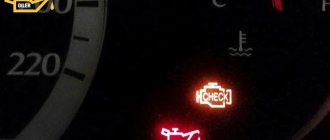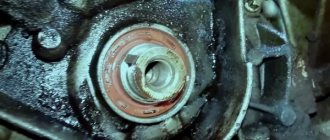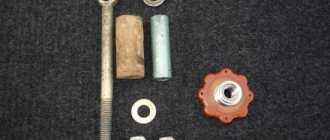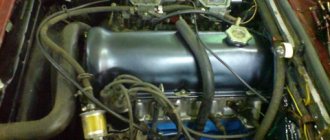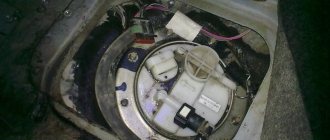What to do if the power steering hums ? This question is periodically asked by most car owners whose cars have this system installed. What could be the causes and consequences of the breakdown? And is it worth paying attention to this at all?
reasons why the power steering hums . Extraneous sounds indicate an obvious malfunction in the control system. And the sooner you fix it, the more money you will save and will not put yourself at risk of getting into an emergency with a faulty steering system of your car.
Power steering device
Air in the system
An air lock in the power steering system can be regarded as an extremely dangerous phenomenon. It is diagnosed by this sign: the liquid in the tank foams and bubbles. It can be eliminated by bleeding the system, with an urgent replacement of mineral water.
As a rule, there are 2 main reasons for air getting into the hydraulics: this happens during ATF replacement or some system components are not tightly connected. In general, the power steering system should not be dirty, so it is recommended to thoroughly flush it.
In some cases, if a little air has entered, you need to turn the steering wheel 5 times all the way in both directions.
Tips for using power steering
In order for the hydraulic booster to work normally and not knock, you must follow a few simple rules:
- Monitor the oil level in the power steering system , top up and change it on time. In addition, check its condition. There is always a risk of purchasing a low-quality liquid, which becomes unusable after a short period of use (check its color and smell).
- Do not hold the wheels in the extreme position (more than 5 seconds) . This is harmful for the power steering pump, which operates without cooling.
- When parking the vehicle, always leave the front wheels level (straight) . This will take the load off the power steering system the next time you start the engine. This advice is especially relevant in cold weather, when the oil thickens.
- If problems occur with the power steering (humming, knocking, increased effort when turning the steering wheel), do not delay repairs . You will not only fix the breakdown at a lower cost, but also protect your car, you and your loved ones from possible emergency situations.
- Constantly monitor the condition of the steering rack . This is especially true for the condition of anthers and seals. This way you will not only extend its service life, but also save money on expensive repairs.
ATF fluid
There can be two problems with liquid: low level and low quality. In the first case, the check is reduced to a visual inspection. You need to open the hood and check the level of filling of the power steering reservoir. According to standards, the liquid should be above o. If lower, there is a leak in the system. As a rule, this happens at joints or on clamps. Systems with old, torn tubes are especially affected. Before topping up, you must urgently eliminate the cause of the leak!
As for the signs of inadequacy of the filled mineral water, the power steering begins to make noise in winter, since operation is not intended in such temperature conditions. The hydraulic booster also hums in cases of low ATF quality. If it contains a high content of impurities, the steering wheel will become increasingly difficult to turn. You can also diagnose dirty liquid visually: it will lose its original color and become crumpled. There is also a way to check: a few drops of oil are tested on white paper. Any color is acceptable except black, gray and brown. In addition, a normal liquid should not smell like burning. It is important to update the ATF within the period specified by the manufacturer - every 60-70 thousand km or 2 times a year.
Bearing
When you hear a power steering hum when you turn the steering wheel, it could be the fault of a damaged outer bearing. It is replaced with a new one after dismantling the pump. It is advisable to remove the bearing using a three-legged puller, without the need to disassemble the unit. This will prevent damage to the shaft. Along with it, the drive belt, reservoir, and repair kit are changed.
It is noteworthy that the power steering noise in this case will more closely resemble a whistle. Noticeable more often in the mornings, when the car is not yet warmed up. It may practically not show itself when the engine is hot. As a rule, there are practically no other reasons why the power steering pump hums.
Extraneous sound when turning sharply
During sharp turns, when the wheels are turned all the way, the load on the hydraulic booster increases many times. As a result, extraneous sound may appear. Which is not necessarily the cause of the breakdown.
- For such subtle differences, you need to thoroughly study the manual when buying a car.
- Manufacturers describe all possible options there, including this one.
- Another reason for the sound when turning the wheels is the blocking of the fluid flow by the bypass valve.
At the same time, the pump begins to heat up. Which can cause serious damage. Do not keep the wheels turned to maximum for more than 5 seconds.
It's buzzing when it's hot
There are several reasons why the hydraulic steering system hums when the engine is hot:
- the pump is completely damaged, especially if a symptom such as steering wheel vibration is added;
- the pump mechanisms are worn out, for example, the bearing, especially if the knock is noticeable at the bottom;
- the wrong fluid is filled in or it has used up its resource - the viscosity of the ATF is lost, the pump does not create the required pressure;
- problems with the steering rack - explained by the fact that at high temperatures the viscosity of the oil decreases, it escapes through damaged oil seals.
Drive unit
The next reason is the drive of the mechanism. The hydraulic booster is driven by the crankshaft pulley. The nodes are connected by a belt drive.
It should have good tension. Otherwise, the pump pressure will be insufficient. In addition to the hum, you will feel that the steering wheel has begun to turn much more tightly, and in addition there will be increased vibration.
Adjust the position of the tension roller. Typically, a 14mm wrench is used for such work. Also check the condition of the belt itself. Of course, if it breaks, the valves will not bend, as on the timing belt. The pump will simply stop producing pressure. However, you should not drive with a cracked belt. If the element has burrs and small cracks, it needs to be replaced. At the same time, check the condition of other belts (alternator and timing gear) that are located nearby.
Check how the belt bearing rotates: it should not whistle. If so, replace the element with a new one.
Humming when cold
If the power steering makes noise on a cold engine, the causes of the malfunction are:
- air suction through low pressure hoses;
- pump bearing failure;
- system contamination.
When a lot of dirt collects at the bottom of the expansion tank, this is a sign of debris getting into the system. The filter in front of the tank (installed on some car models) can also become clogged.
To eliminate air leaks, it is better to put two high-quality clamps on the tube laid from the tank to the power steering. It is advisable to coat the clamps with sealant after tightening. It is also recommended to replace the ring installed on the pump inlet. Air may be sucked in from loose connections in oil hoses, steering rack or pump. Therefore, where possible, additional clamps should be installed.
The following measures will also help:
- replacing the seal at the outlet of the expansion tank;
- bleeding air by turning the steering wheel to extreme positions with the engine running;
- replacing the oil seal in the power steering pressure suction valve;
- replacement of all rubber gaskets included in the repair kit.
If a lot of dirt is found at the bottom of the tank, you need to remove the slurry and rinse the container thoroughly. Even minor clogging will eventually lead to wear of the power steering pump elements - it will begin to make a hum and knock. Sometimes it makes more sense to renew the tank and filter rather than try to wash them. The steering rack should also be removed, disassembled and cleaned.
Recommendations for extending the service life of power steering
In some cases, it is useful to add special additives to the power steering fluid. They relieve the force on the steering wheel, improve the operation of the unit as a whole, reduce vibrations and protect elements from wear. However, the components must be of very high quality, not fake, otherwise the mechanisms will begin to fail even faster, and the power steering pump will hum louder.
Particular attention is paid to the choice of ATF. First of all, the liquid must correspond to the temperature characteristics of a specific climate zone. Thus, mineral waters with the wrong viscosity will not cope with their functions in frosts below 15-20 ° C.
List of car models on which the problem most often occurs
| Cars | Disadvantages of power steering and steering |
| Gazelle | There is a problem with the oil seal on the column, so the steering wheel sticks. The power steering hose was poorly thought out by the engineers, as it is located close to the manifold, and there are no protective screens. If it bursts, a fire may start under the hood. There are also problems with the fitting of the factory power steering pump. On ZF and Japanese pumps, the outlets are made for a bolt fitting, and such problems do not arise. |
| Lada Largus | If the amplifier fails, the ability to drive the car remains, but the force on the steering wheel increases. Sometimes power steering malfunctions can be detected with the appearance of extraneous noise, for example, a whistle or hum; in another case, the system hoses may leak. |
| Lada Priora | The main disadvantage is the cumbersomeness of the entire system. On Priors, it is not recommended to hold the steering wheel in the extreme right or left position for more than 5 seconds. The mechanism requires constant monitoring of the oil level, inspection and replacement of drives, hoses, and pump. The pump depends on the operation of the engine, which means it takes a certain percentage of power from the power plant. If the power steering does not work when driving in a straight line, this percentage of power is wasted. The system does not imply setting operating modes depending on the speed of movement or the angle of rotation of the steering wheel. At high speed, the sensitivity of the steering mechanism is lost. |
| VAZ 2110 | Frequent problems: factory oil, hoses with clamps, air leaks, problems with belt tension, pump and seals. |
| Ford Mondeо IV | The weak point of the Mondeo is the steering, or rather the power steering. It often breaks down. The steering rack itself is easy to tighten, and steering rods and ends (2300 and 1500 rubles) usually require replacement after 60–70 thousand kilometers. |
| Renault SANDERO | Power steering Renault Sandero is a reliable vehicle component, but under certain conditions it can fail quite quickly. Often the cause is a power steering fluid leak, a broken pump drive belt, or a ruptured hose in the system. |
| KIA Rio | On these cars, the following problems with power steering are more often observed: the hydraulic drive tube touches surrounding parts, the return hose of the power steering is pinched, air gets into the hydraulic drive, and weak force from the power steering pump is observed. Also, over time, the steering shaft and gear lose proper alignment, and the elastic coupling rotates with deformations when the steering wheel is turned. Whenever there is any contact between metal parts, a hissing sound is transmitted into the interior through the elastic coupling. |
| Chery Tiggo | Often there is a whine of the power steering, there are shocks and jerks in the steering wheel, and sometimes the dashboard even shakes. The amplitude of the jerks decreases after several turns of the steering wheel. On a cold engine, the power steering works like a clock - you can turn the steering wheel even with your finger at idle, but as the car warms up (idling speed < 1000), problems are observed - the steering wheel becomes tight. If you increase the speed, everything will return to normal. |
If you have any questions, leave them in the comments below the article. We or our visitors will be happy to answer them
Grinding, as well as squeaking (the steering wheel turns both when driving and when standing still)
A grinding/creaking sound that is felt when the steering wheel is turned in different directions. This noise occurs due to wear on the suspension joints or steering joints. Similar to the previous point, here you will need to diagnose the suspension components or steering system, replacing worn parts, if necessary.
However, the most common reason for such a sound is the lack of lubrication in the steering tips (as well as their severe wear).
Sometimes such a squeak can even be accompanied by a crunching sound, regardless of whether the car is moving or standing still. In this case, the culprits are the lower ball joints (sometimes the shock strut bearings). The first option is also accompanied by play in the steering wheel when the car is suspended.

